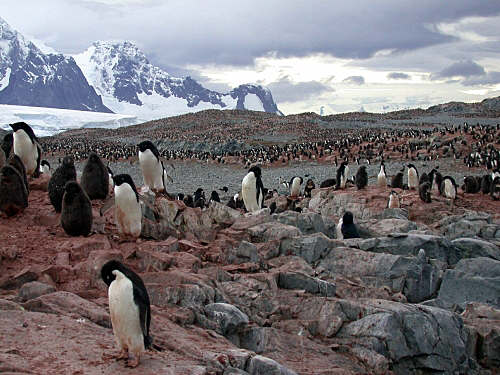Page 2/2 - Posted November 26, 2010
Researchers to deploy AUV to image seafloor speciesIn 2007, Thatje and British colleagues spied a species of crab, Paralomis birsteini, between 1,100 and 1,300 meters on the continental slope off Marguerite Bay, about in the middle of the Antarctic Peninsula. That’s where the team will begin its investigation before heading farther south to the Amundsen and Bellingshausen seas. He and colleagues published the finding in 2008 in the journal Polar Biology. More recently, in November 2010, he co-authored another paper in Polar Biology that analyzed the distribution of 17 species of king crab, which lived at depths between 550 and 1,600 meters, in the Southern Ocean. [See press release The results showed that king crabs prefer relatively warm waters, and the coldest waters in which they have been found were those of the Ross Sea, with 0.4 to 0.5 degrees Celsius. Water temperature at the surface can be as low as minus 1.8 degrees Celsius, the salinity keeping it from freezing. “The paper provides a ‘physiological map’ to the known crab records in the Southern Ocean in relation to local temperature settings,” Thatje said via e-mail. “This is instrumental for any potential changes in their distribution. In theory we can now predict how the distribution of some of these species may change as waters continue to warm in key areas of the [Western Antarctic Peninsula].” Earlier this year, scientists aboard the research vessel Nathaniel B. Palmer The shipboard team will tackle the project from several angles. 
Photo Credit: Tom Kleindinst/ Woods Hole Oceanographic Institution
WHOI scientist Hanu Singh stands by SeaBED, an undersea robot capable of shooting a photo every three seconds.
Foremost among the tools the researchers will use is an autonomous underwater vehicle (AUV) from the Woods Hole Oceanographic Institution called SeaBED “It allows us to fly it just over the surface of the benthos and to see a level of detail that is just stunning,” McClintock said. In this case, the AUV won’t work autonomously. The ships — first the USAP’s Nathaniel B. Palmer and later the Swedish icebreaker Oden “That’s another exciting thing about this project: There’s a component of developing this technology to fly these AUVs,” Aronson said. Another instrument called an epibenthic sledge will also cruise along near the bottom of the seafloor to sample the crab’s dermersal larvae, which develop just above the benthic communities. In addition, the ships will tow nets to capture plankton, floating organisms in the water, to see what species of crab larvae are being carried near Antarctica. In previous work in Antarctica with other colleagues, McClintock has studied the function and evolution of chemical defenses used by some benthic organisms. Some of the compounds they have isolated in the past show promise as cancer therapies or even pesticides. Now McClintock worries Antarctica’s natural laboratory may be irrevocably altered. “These [compounds] are coming out of organisms that could be decimated by these crabs, and we might lose an opportunity to discover something that has benefits to mankind, because these communities are going to be so radically altered you lose 30 million years of evolution of these unique species.” Warned Aronson: “We’re expecting some major changes as warming proceeds. … Crabs do have a big impact on benthic communities.” NSF-funded research in this article: Richard Aronson, Florida Institute of Technology, Award No. 0838846 |



For USAP Participants |
For The Public |
For Researchers and EducatorsContact UsNational Science FoundationOffice of Polar Programs Geosciences Directorate 2415 Eisenhower Avenue, Suite W7100 Alexandria, VA 22314 Sign up for the NSF Office of Polar Programs newsletter and events. Feedback Form |


